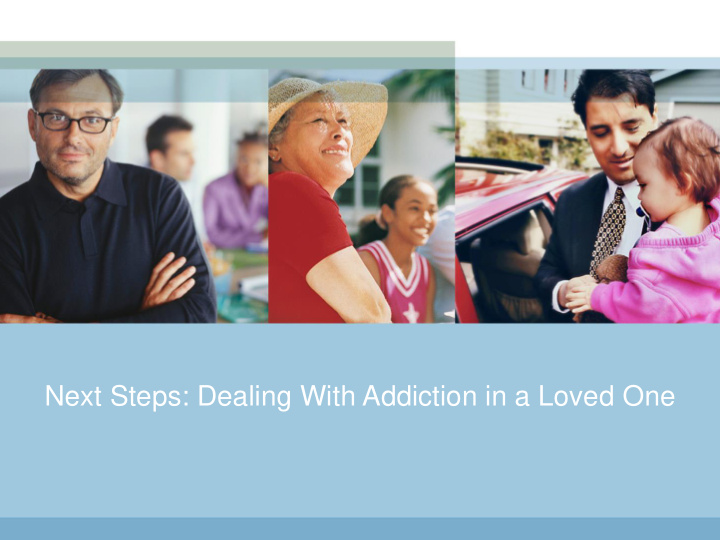



Next Steps: Dealing With Addiction in a Loved One
Presenter Racquel Merritt, MSW, LCSW, LCAS EAP Counselor Racquel Merritt is an EAP counselor, licensed clinical social worker, and licensed clinical addictions specialist. She has a diverse counseling background in substance use, severe and persistent mental illness, and spiritual health and wellness. She has been working in the field for over six years and enjoys connecting with people all over the world and assisting them as they progress through life’s challenges on a daily basis.
Learning Objectives • Define addiction • Learn some warning signs of addiction • Discuss how to handle addiction issues • Identify sources of support for both the loved one and yourself
Over 20 million people in the United States have issues with addictions
What is an Addiction? • A disease of the brain or thought process that leads to an individual becoming preoccupied with a certain behavior • After engaging in the behavior over a period of time, the person’s brain chemistry is changed, and the person experiences only pleasure from the behavior and is not able to resist the impulse to engage in the behavior • The person will compulsively seek out the behavior and engage in the behavior in spite of experiencing harmful consequences
Did You Know? No two persons with addiction issues are the same
What are the Warning Signs? • Repeated arguments with family members • Irritability, depression, and or mood swings • Engages in behavior alone or in secrecy • Hides or is dishonest about how often engages in behavior • Changes in personal hygiene-looking disheveled • A family history of addiction • Experiences withdrawal symptoms when not able to engage in behavior
Poll From the warning signs listed in the previous slide, have you noticed any of these signs? A. Yes B. No What are the next steps?
Stages of Change • Pre-contemplation • Contemplation • Preparation • Action • Maintenance • Relapse
What’s Next? • Set healthy boundaries • Seek counseling • Provide resources • Express your love and concern
They are not Alone… Within a day, more than 700,000 people seek treatment for drug or alcohol addiction
Poll Are You an Enabler? • Do you often make excuses for your loved one’s behavior? • Do you take care of your loved one financially? • Do you take on your loved one’s responsibilities?
Treatment for Addiction Issues • Outpatient therapy or counseling • Detoxification services • Self-help and peer support groups • Inpatient or residential counseling/therapy
Locating Treatment Centers • The Substance Abuse and Mental Health Services Administration – http://www.samhsa.gov • Contact your EAP
Support Groups • Alcoholics Anonymous • Narcotics Anonymous • Marijuana Anonymous • Gambling Anonymous • Al-Anon Family Support Groups
For More Information… Contact Your EAP Or Work-Life Program For Assistance
Thank You Questions? 3180
Works Cited TriHealth. (2016). 3 Ways to support a loved one struggling with addiction . Retrieved on June 6, 2016. Retrieved from https://www.trihealth.com/dailyhealthwire/miscellaneous/3-ways-to-support-a- loved-one-struggling-with-addiction Renew Media, LLC. (2011). Addiction & recovery: The stats . Retrieved on June 6, 2015. Retrieved from http://www.reneweveryday.com/resources/addiction-recovery-facts National Council on Alcoholism and Drug Dependence. (2015). Helping a family member or friend . Retrieved on May 26, 2016. Retrieved from https://www.ncadd.org/family-friends/there-is- help/helping-a-family-member-or-friend Substance Abuse and Mental Health Services Administration. (2015). Recovery and support . Retrieved on June 1, 2016. Retrieved from http://www.samhsa.gov/recovery National Council on Alcoholism and Drug Dependence. (2015). Signs and symptoms . Retrieved on June 1, 2016. Retrieved from https://www.ncadd.org/about-addiction/signs-and-symptoms/signs- and-symptoms Virginia Polytechnic Institute & State University. (2009). The stages of change . Retrieved on May 27, 2016. Retrieved from http://www.cpe.vt.edu/gttc/presentations/8eStagesofChange.pdf
Recommend
More recommend